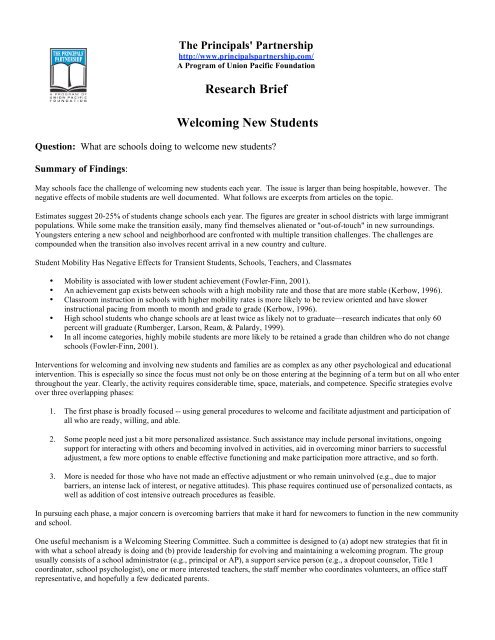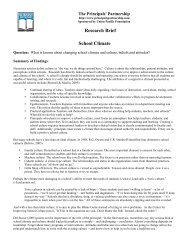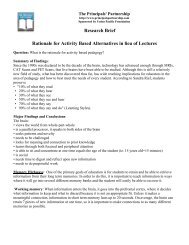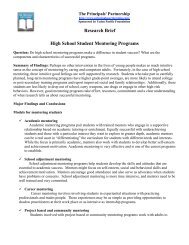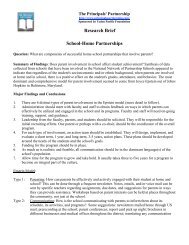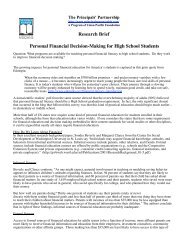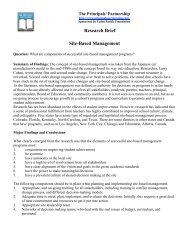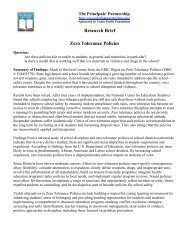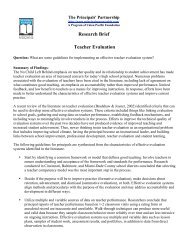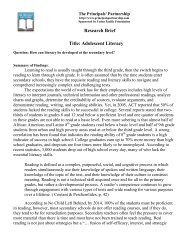Research Brief Welcoming New Students - Online Effectiveness ...
Research Brief Welcoming New Students - Online Effectiveness ...
Research Brief Welcoming New Students - Online Effectiveness ...
- No tags were found...
Create successful ePaper yourself
Turn your PDF publications into a flip-book with our unique Google optimized e-Paper software.
The Principals' Partnershiphttp://www.principalspartnership.com/A Program of Union Pacific Foundation<strong>Research</strong> <strong>Brief</strong><strong>Welcoming</strong> <strong>New</strong> <strong>Students</strong>Question: What are schools doing to welcome new students?Summary of Findings:May schools face the challenge of welcoming new students each year. The issue is larger than being hospitable, however. Thenegative effects of mobile students are well documented. What follows are excerpts from articles on the topic.Estimates suggest 20-25% of students change schools each year. The figures are greater in school districts with large immigrantpopulations. While some make the transition easily, many find themselves alienated or "out-of-touch" in new surroundings.Youngsters entering a new school and neighborhood are confronted with multiple transition challenges. The challenges arecompounded when the transition also involves recent arrival in a new country and culture.Student Mobility Has Negative Effects for Transient <strong>Students</strong>, Schools, Teachers, and Classmates• Mobility is associated with lower student achievement (Fowler-Finn, 2001).• An achievement gap exists between schools with a high mobility rate and those that are more stable (Kerbow, 1996).• Classroom instruction in schools with higher mobility rates is more likely to be review oriented and have slowerinstructional pacing from month to month and grade to grade (Kerbow, 1996).• High school students who change schools are at least twice as likely not to graduate—research indicates that only 60percent will graduate (Rumberger, Larson, Ream, & Palardy, 1999).• In all income categories, highly mobile students are more likely to be retained a grade than children who do not changeschools (Fowler-Finn, 2001).Interventions for welcoming and involving new students and families are as complex as any other psychological and educationalintervention. This is especially so since the focus must not only be on those entering at the beginning of a term but on all who enterthroughout the year. Clearly, the activity requires considerable time, space, materials, and competence. Specific strategies evolveover three overlapping phases:1. The first phase is broadly focused -- using general procedures to welcome and facilitate adjustment and participation ofall who are ready, willing, and able.2. Some people need just a bit more personalized assistance. Such assistance may include personal invitations, ongoingsupport for interacting with others and becoming involved in activities, aid in overcoming minor barriers to successfuladjustment, a few more options to enable effective functioning and make participation more attractive, and so forth.3. More is needed for those who have not made an effective adjustment or who remain uninvolved (e.g., due to majorbarriers, an intense lack of interest, or negative attitudes). This phase requires continued use of personalized contacts, aswell as addition of cost intensive outreach procedures as feasible.In pursuing each phase, a major concern is overcoming barriers that make it hard for newcomers to function in the new communityand school.One useful mechanism is a <strong>Welcoming</strong> Steering Committee. Such a committee is designed to (a) adopt new strategies that fit inwith what a school already is doing and (b) provide leadership for evolving and maintaining a welcoming program. The groupusually consists of a school administrator (e.g., principal or AP), a support service person (e.g., a dropout counselor, Title Icoordinator, school psychologist), one or more interested teachers, the staff member who coordinates volunteers, an office staffrepresentative, and hopefully a few dedicated parents.
The Principals' Partnershiphttp://www.principalspartnership.com/A Program of Union Pacific Foundation<strong>Research</strong> <strong>Brief</strong>States are developing programs in an attempt to lower student mobility rates and mitigate the effects of mobility on students'education. Examples of these programs and strategies include:• providing outreach to educate parents about minimizing the negative effects of mobility,• creating "buddy systems" by partnering new students with current students,• implementing district-wide and state-wide standardized curricula,• developing efficient student record-tracking systems between schools and districts, and• providing professional development to assist teachers in meeting the needs of highly mobile students.<strong>Online</strong> Resources:Easing the Impact of Student Mobility: <strong>Welcoming</strong> & Social SupportEstimates suggest 20-25% of students change schools each year. The figures are greater in school districts with large immigrantpopulations. While some make the transition easily, many find themselves alienated or "out-of-touch" in new surroundings.Youngsters entering a new school and neighborhood are confronted with multiple transition challenges. The challenges arecompounded when the transition also involves recent arrival in a new country and culture.http://smhp.psych.ucla.edu/easimp.htmA Table from our newsletter Addressing Barriers to Learning,Vol. 2 (4), Fall 1997Outline of <strong>Welcoming</strong> Steps and Activities. A terrific list of activities to welcome new students.http://smhp.psych.ucla.edu/fall97.htmStudent Mobility"Student mobility" refers to the phenomenon of students changing schools for reasons other than grade promotion. <strong>Students</strong> whotransfer frequently between schools during the school year are at greater risk for academic and behavioral problems (Hartman,2002). Some research suggests that differences in student achievement between non-mobile and mobile students can also beattributed to students' background characteristics (Rumberger, 2002). For example, a Minneapolis-based study found a strongrelationship between mobility and a student's race and family income (Kids Mobility Project, 1998)http://www.edweek.org/rc/issues/student-mobility/Student Mobility's Effect on Academic AchievementFor children caught in the shuffle, frequent moves into different schools and/or homes can negatively impact academicperformance. With poverty and mobility both contributing to the achievement gap—and with poverty being highly correlated withmobility—understanding how these issues jeopardize achievement is critical.http://www.ncrel.org/policy/pubs/html/rmobile/effect.htmAddressing the Causes and Consequences of High Student Mobility: The Role of School Systems and CommunitiesA Forum — March 1, 2002Approximately one-quarter of this nation's students change schools three or more times over the course of a public school career.High student mobility has consequences for students, both mobile and non-mobile, and can threaten educational attainment,curriculum continuity and school stability. For students, the long-term effects of high mobility include lower achievement levelsand slower academic pacing, culminating in a reduced likelihood of high school completion. For residentially unstable students,such as homeless, migrant and foster care children, high mobility is another barrier, among others, to an adequate education. Lowincomeand minority students are more likely to experience excessive classroom mobility, and the deleterious effects of thistransience are most severe for such students.http://www.aypf.org/forumbriefs/2002/fb030102.htm
The Principals' Partnershiphttp://www.principalspartnership.com/A Program of Union Pacific Foundation<strong>Research</strong> <strong>Brief</strong>Searching for Stability:The negative effects of high mobility are well documented, but how can schools address students' needs amid the pressure ofaccountability? The number of kids who change schools is astounding. And their mobility rates keep climbing. Chicago PublicSchools, which has long struggled with high mobility, reports that 23 percent of students who entered first grade in 1999 hadchanged schools by the end of the year. Four years after entering first grade, more than 50 percent had changed schools, a trendthat’s continued despite districtwide efforts to reduce mobility, says CPS research analyst Jeffrey Rosen.http://www.asbj.com/2006/09/0906research.htmlSubmitted Date: 10/30/2006 By: Mike Muir, Maine Center for Meaningful Engaged Learninghttp://www.principalspartnership.com/This is provided as a service to educators by The Principals Partnership and Union Pacific Foundation, neither of which assumes any responsibility for the contentof the brief or the positions taken by the authors or the Web sites or other authors whose works are included. This research brief reflects information currentlyavailable and is not the official position of The Principals Partnership or Union Pacific Foundation.Disclaimer: All URLs listed in this site have been tested for accuracy, and contents of Web sites examined for quality, at the time of addition. Content accuracy andappropriateness, however, cannot be guaranteed over time as Web sites and their contents change constantly. The author takes no responsibility for difficultieswhich may result from the use of any Web site listed herein. Please notify the Webmaster if you find any dead links or inappropriate material.Permission: You may use or download content for research or educational purposes, or for your personal, noncommercial purposes, provided you keep unchangedall copyright and other notices with them. No other use of any content is permitted. You agree that you will make only lawful use of this research brief, and willonly use these briefs in compliance with all federal, state and local laws and regulations. You agree that you will make no use of the research that violates anyoneelse's rights, including copyright, trademark, trade secret, right of privacy, right of publicity or other rights.


